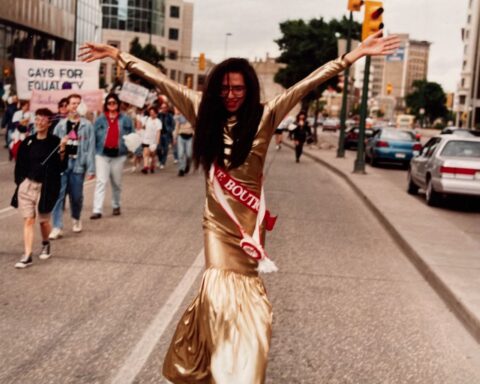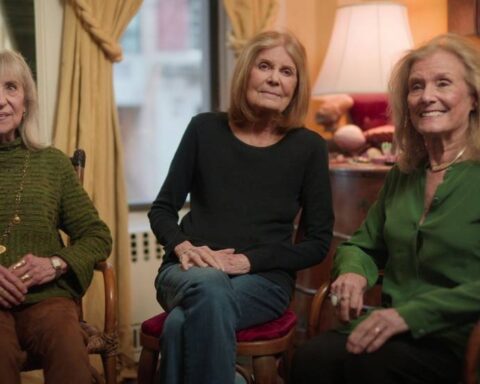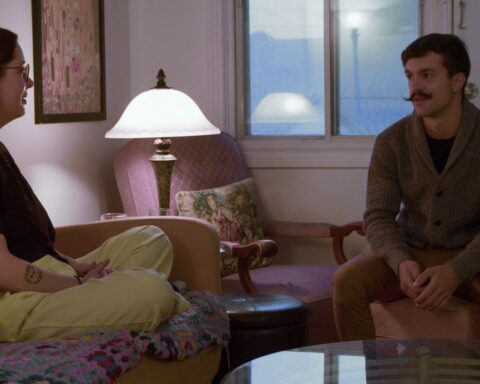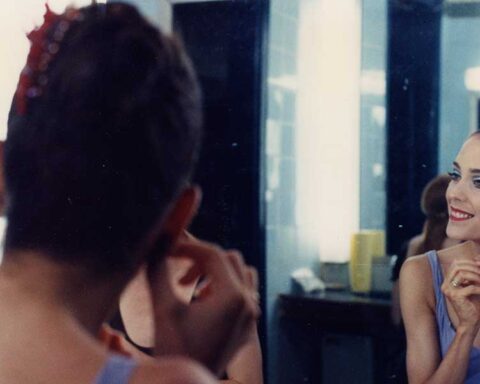Bare
(Belgium, 94 min.)
Dir. Aleksandr M. Vinogradov
Programme: Artscapes (World Premiere)
Editions of Hot Docs in the post-#MeToo era might lead cinephiles to believe that all men are dicks. This year, Hot Docs reclaims the dick with the phallus-friendly dance doc Bare. The film has more, er, “gents” on display than a trip to the beach on Toronto’s Centre Island. Told with neither an erotic whisper nor a juvenile giggle, Bare celebrates the male body in all its complexity, might, and vulnerability.
This unconventional dance doc pulses with originality. It’s an edgy thrill for viewers thirsty for experimental art when galleries and theatres are shut like a nun’s knees. Bare chronicles the preparations for Belgian choreographer Thierry Smits’ provocative dance piece Anima Ardens (Burning Soul). Anima Ardens features 11 male dances, all of whom appear completely nude for the duration of the performance. The furiously hypnotic energy of the performance invites audiences to explore the male body, which rarely receives the same level of aesthetic consideration in fine art as female nudes do, Michelangelo statues aside. The film features men of all shapes, heights, builds, and—let’s get this out of the way now—penis sizes as the dancers bounce, jump, roll, and wiggle around the pristine white backdrop and unsanitary stage.
Director Aleksandr M. Vinogradov films the 11-month preparation for Anima Ardens and offers a window into a unique artistic collaboration. The auditions introduce a unique dynamic that transforms as the film progresses. Smits asks his prospective dancers if they have read the performance description in full and understand that the piece is to be done in the nude. Several dancers are visibly surprised and uncomfortable as they begin crossing their fully clothed legs and twitching anxiously. However, Smits makes clear that he isn’t choosing men based on their abs or their endowments. They are dancers, after all, and the audition scenes offer a survival of the fittest challenge as the top dancers distinguish themselves through technique, form, and confidence.
Anima Ardens demands that the dancers abandon all squeamishness and prudishness. The choreography directly confronts notions of masculinity and sexuality as it brings men together, creating a uniquely homosocial space in which the dancers writhe on the floor or connect their bodies to create pyramids of burly strength. Bare explodes notions of queerness and masculinity as the dance numbers task the men with exploring one another’s bodies, eschewing all insecurity about brushing a colleague’s manly bits in the service of art.
There are images of birth and renewal as the dancers crawl between the bodies of their peers in one of the piece’s numbers that are more challenging. Smits implores the dancers to loosen up and discover new energy as two men merge to form a birth canal through which a third dancer wiggles and emerges. (It’s quite a peculiar sight.) Similarly, the dance assumes avant-garde theatricality as another sequence tasks each man with creating his own birth scene. The dancers scream, moan, and squat as they use their bodies to evoke the physical feat of child labour. In each shot, the men’s tight muscles constrict and release, culminating in a hypnotic sea of skin and strength as men interpret the female act of labour.
Verité-style observations of the dance troupe appear between excerpts of the stunningly choreographed performances. These interludes are as revealing as the dance sequences with their deconstruction of masculinity and gender norms. From the auditions to the final performance, Bare witnesses an erosion of insecurity as some dancers take time to emerge from their shells. One dancer observes the beauty of nudity by saying it “opens up sides of themselves they normally don’t show.” This observation is astute, since restrictive notions of masculinity generally expect men to be closed and guarded. As the rehearsals progress towards opening night, Bare sees the men become looser on stage and open up with each other.
For example, one sequence sees an unexpected striptease to Madonna’s Die Another Day between rehearsals.* This candid voguing humorously capitalises on a song devoted to the most antiquated of alpha males (James Bond) sung by one of pop culture’s most iconic performers of female sexuality. Another sequence hilariously taps into notions of “locker room banter” as the dancers hit the showers after rehearsals. The static camera observes the dancers emerge from the steamy bath to discover a very phallic shotgun microphone, still recording, left unattended in the room. One by one, the dancers send-up notions of “boys will be boys” by approaching the mic and wagging their genitals from side to side, slapping their members against their legs for the unsuspecting sound recordist to discover. Thanks to their time on the dance floor, the men are comfortably loose and free in the buff.
Vinogradov’s film might ultimately be more productive than Smits’ piece thanks to the dance Bare creates between gender identity as a performance and a natural state. The excerpts of Animus Ardens, while a sight to behold, amount to an array of aimless compositions. Even the dancers complain to Smits that the piece lacks narrative coherence. The film, however, wrestles with the tensions within the troupe and the personal explorations of the self each dancer undertakes while baring himself to the world. The sumptuous cinematography and ruptured kinetic editing further breaks down the male body with a bacchanal of close-ups as the camera caresses thighs, feet, buttocks, and shafts. These emblems of masculinity appear in rapid-fire montages amid snippets of Hieronymus Bosch paintings and title cards boasting emphatic words like “male,” “phallus,” and “strength.” The film strips bare notions of masculinity, gender, and sexuality, creating something altogether new and exciting.
Bare screens at Hot Docs’ online festival beginning May 28.
It also screens at DOC NYC beginning Nov. 12.
Visit the POV Hot Docs Hub for more coverage from this year’s festival.











